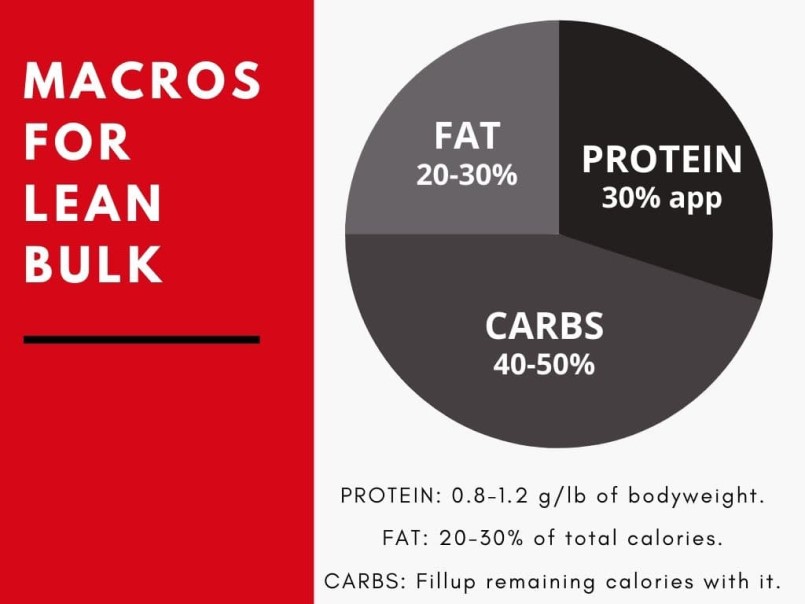Muscle building is not at all an easy process. It takes proper discipline and dedication to build an aesthetic physique. On top of that, it may take several months to see some noticeable changes in your body.
However, if you play your game smartly with correct science-based information, then you can achieve faster and better results. This article will give you a precise number that “how many calories should you eat to gain lean muscle?”. So let’s get started.
How Many Calories Do You Need To Gain Lean Muscle?
Well, when we talk about the calorie requirement, then there’s no one-size-fits-all. The amount of calories one should consume to gain lean muscle depends on various factors. This strongly depends on your body composition, training intensity, metabolism, and your daily calorie expenditure.
By doing some calculations, you can easily find your exact calorie requirement. Here are the three simple steps to determine how many calories you should eat to gain lean muscle mass.
Step 1 – Find Your Maintenance Calories
First of all, you should know the number of calories you need to maintain your current body weight. You can get your maintenance calories by calculating your BMR (Basal Metabolic Rate).
Basal Metabolic Rate (BMR) gives you a rough estimate of the number of calories you require to maintain your weight.
You can use an online calculator for this or simply estimate by the following two steps.
A – Multiply your body weight in pounds by 10 or 11 on the basis of your gender:
- Men = weight in pounds x 11
- Women = weight in pounds x 10
B – Now multiply this number with one of the following depending on your activity level.
- multiply by 1 – no exercise (sedentary lifestyle).
- 1.1 – Light exercise for 2 to 3 days per week.
- 1.2 – Moderate exercise 3 to 5 days per week.
- 1.4 – Hard exercise 4 to 6 days per week.
- 1.6 – Intense workout daily (twice a day).
The number you’ll get after this would be your daily maintenance calories. For instance, a 150-pound guy John, who does hard training 4-6 days a week, the maintenance calories would be: 150 x 11 x 1.4 = 2310.
Step 2 – Add A Caloric Surplus
The calories you got in step 1 are your maintenance calories. In order to gain lean muscle mass, you have to add extra calories to that number. This is called a “caloric surplus” (eating more than the requirement).
Remember, studies show that more calories don’t mean more growth (1). Consuming too many extra calories may be bad for you as it can result in fat storage.
So how big your caloric surplus should be?
If your surplus calories are too low, you won’t be able to gain muscle and if the surplus is too big, you may get fat. Hence, it is very crucial to pick a sweet spot.
Generally, adding about 10% extra calories is enough to gain lean muscle. For instance, if your daily calorie requirement is 3000, then you should consume about 3300 calories for muscle gain.
However, irrespective of your calorie needs, about 250 to 500 surplus calories are enough to gain lean muscle mass. As there’s no one size fits for all, you can change your daily calories as per your results.
250-500 surplus calories are sufficient to gain lean muscle mass. Pick any number in this range, add it to the BMR you got in step 1, and start your muscle-building journey.
Studies show that lean individuals with low-fat percentages can take large surplus calories to gain muscle (2, 3, 4). While the people with higher body fat percentage are more prone to fat gain. Hence, they should stick to a slight caloric surplus.
Going beyond 500 extra calories won’t help you in gaining more muscle. Since your body has a limit to the rate of muscle growth, the rest of the excess calories would be stored as fat in your body.
Step 3 –Adjust Your Macros
Having a good estimate of how many calories you need to eat daily is not enough to gain lean muscle. Just blindly filling those calories won’t give you the required results. You have to set proper macros for a lean bulk.
Adjusting your macronutrients is a very crucial step in gaining lean muscle. This simply means maintaining a perfect balance of protein, carbohydrates, and fats in your diet.
Consuming enough calories is not enough unless your macronutrient ratio is not perfect. So let’s look at them one by one.
How much protein you need to gain muscle?
Protein is the most important macronutrient for building lean muscle tissue. It is the building block of muscle. Hence it is necessary to eat enough protein to gain muscle.
However, more is not necessarily better. You have to eat in an optimal range to maximize muscle hypertrophy and recovery.
Consuming 0.8-1.2 grams of protein per pound of bodyweight is an optimal range to gain lean muscle mass (5).
For beginners, less protein is sufficient. While if you already having a decent amount of muscle mass then stick to the higher side. Here are the 13 Best Foods for Lean Muscle Gain. Check it out.
Carbs and fat!
First, you have to estimate the amount of fat you need to eat.
During muscle gain, about 20-30% of your daily calories should come from fats.
Now, after fixing your daily requirement of protein and fat, fill the rest of your calories with carbohydrates.
For example: if you need 150 grams of protein and 3000 calories daily to gain muscle, then taking a moderate amount of fat (25%) means:
3000 x 0.25 = 750 calories from fat
As 1 gram of fat contains 9 calories so your fat intake would be
750/9 = 83 grams of fat
Now fill the rest of your calories with carbohydrates.
- 150 grams of protein means 150 x 4 = 600 calories.
- 750 calories from fat.
- Remaining calories: 3000 – 600 – 750 = 1650 calories from carbs (i.e, 410 gm of carbs).

Note: As everybody reacts differently, hence I have given the numbers in a range. Start with the average, then optimize if you’re not getting the required results.
Read more: Calculate Your Macros For Lean Bulk in 3 simple steps
Why Training Is Not Enough
Muscle building stands on three pillars: Training, Nutrition, and Rest. You have to put efforts in all three. If you lack behind in any one of them then you won’t get the desired results.
Some people give their 100% in the gym but compromise with their diet. Due to this, they don’t get the required results on time. No matter how hard you are training, if your nutrition is not up to the mark then you can’t get that ripped muscular physique.
However, you can cheat a little bit, like for one or two cheat meals weekly. But eating junk frequently is a big mistake as nothing can compensate for a bad diet.
You may get stronger with this but to get a lean, muscular, and aesthetic physique, you have to provide the right kind of food to your body.
Related: How To Get Ripped (3 steps to get Shredded)
How To Gain Muscle Fast
We all want to gain muscle as fast as possible but the truth is that it’s actually a slow process. Beginners can expect to gain muscle faster but it becomes slower as they do progress.
This model gives a rough estimate that as an average individual, how much muscle you can gain in a month:
| Years of proper training | Category | Muscle Gain per month |
|---|---|---|
| 1 | Beginner | 1.4-2.0 lbs |
| 2 | Intermediate | 0.8-1.6 lbs |
| 3+ | Advanced | 0.4-0.8 lbs |
The rate of building muscle mainly depends on your training experience and genetics. But you can speed up the process by doing the right things in the right way. Here are the 3 science-based training tips to speed up your muscle-building process.
1. Progressive Overloading: It is a technique in which you gradually increase the metabolic stress on your muscles.
It’s a crucial technique that if you use smartly, you would definitely boost your muscle-building process. You can do this by increasing the weight you are lifting, by doing more sets, or by reducing the rest period between sets.
Read more: Progressive Overload Training Principle 101
2. Mind-muscle connection: When you are in the gym, don’t let your mind wander anywhere else. Mind-muscle connection simply means putting your full focus and attention in your exercise and consciously contracting the muscle.
Studies shows that this simple shift in focus increases your target muscle activation and results in faster muscle growth (6).
Read More: 5 Ways To Improve Mind-Muscle Connection
3. Train for hypertrophy: An increase in the size of your muscle cells is called muscle hypertrophy. Do most of your sets in the hypertrophy rep range (6 to 12 reps per set).
Read more: How To Maximize Muscle Hypertrophy?
Calories To Gain Muscle – SUMMARY
So this was the article explaining how many calories should you eat to gain lean muscle. Hope you found it helpful in your fitness journey.
Here is a quick recap of estimating your daily calorie need for a lean bulk in three steps:
- Calculate your BMR simply by using an online calculator. This will give you the daily calories you need to maintain your weight.
- Now add a calorie surplus of 300-500.
- At last, set up your macro distribution:
- Protein: 0.8-1.2 gm per lb of bodyweight.
- Fat: 20-30% of your daily calories.
- Carbs: Fill the remaining calories with carbohydrates.
Thanks for reading this so far. For any query regarding fitness, you can ask me in the comments. For daily fitness facts and motivation, please follow us on Instagram.



